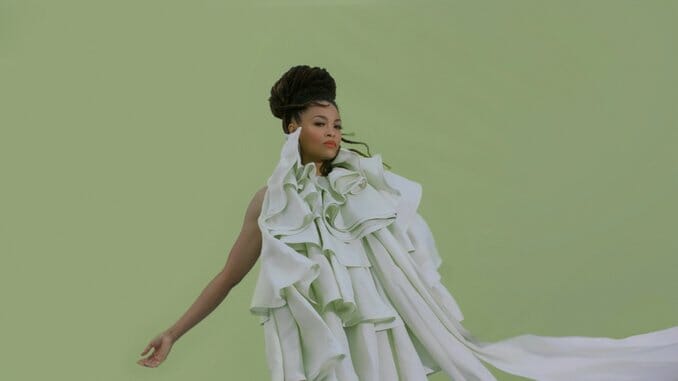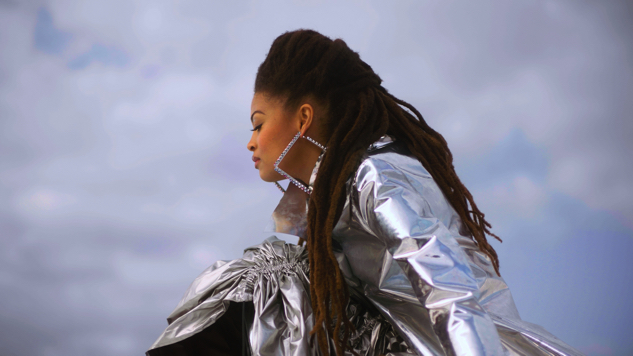The Curmudgeon: Valerie June Multiplies Her Voice
Photos by Renata Raksha
Valerie June’s terrific new album, The Moon and Stars: Prescriptions for Dreamers, opens with echoing, broken acoustic-piano chords—the sound of a small, wooden, Southern church. June soon enters with her acoustic guitar, singing in her twangy soprano, “I don’t know how long I’ll stay / No, I can’t tell you lies that way.” Is she singing to a lover about the uncertain duration of their relationship? Is she singing to a congregation about the uncertain duration of her time on Earth? It works either way, especially when she adds, “I’ve had not one regret.”
This is the traditional, acoustic music of rural Afro-America, the tonality that first made June’s reputation back in 2013, when Pushin’ Against a Stone became her first nationally distributed album. She has put that style to her own uses, with quirky original songs, but that sound, which cuts against the grain of this century’s urban, microchip Black music, has given her a distinct identity.
It’s still there on The Moon and the Stars but June and her co-producer Jack Splash have found a way to build a new sound atop the old one, giving her a new future without discarding her past. This is artistic evolution not by substitution but by addition—always the better approach.
On that opening song, “Stay,” for example, the old-fashioned opening is bolstered by drums and bass on the second chorus, further reinforced by electric guitar and electric keys on the next verse. By the third chorus, the subliminal string quartet steps forward in a swelling chart by legendary Stax Records arranger Lester Snell. By the time the flute improvising over the drummer’s march beat leads into a crescendo of female vocals (all multi-tracked by June), what once seemed intimate and personal has become large and social.
“I wanted that sense that at first this is just Valerie singing about her love, her life,” June says over Zoom from her home in Brooklyn. “But as it goes on, it becomes a song about a whole town, a multiplicity of happenings that we’re all a part of. I wanted the songs to be like an art installation where you walk into a room, and you’re part of it, you can sit and look or you can dance around. That’s what I wanted where you could have a variety of perspectives.”
Most of the songs follow the same strategy. They begin with just the singer and her banjo, her acoustic guitar and/or one other ingredient. Only gradually are the other elements placed on top. As the music swells with slowly accumulating sound into a massed cloud of notes, just when you might forget where June started from, the new layers suddenly evaporate and reveal that the artist we’ve always known is still there at the heart of the song.
As a result, each song achieves what music always wants to do and too rarely accomplishes: It gives us both the individual experience—the lone voice with its distinct point of view—and the communal experience—the surrogate voice for each of us and our shared history. More than that, it reveals how the former evolves into the latter.
“These arrangements reflect the way I write songs,” she reveals. “They come quietly like that, and I’ll hear the song as just my voice. Then I’ll hear a second voice that I can add as guitar or banjo. Then I’ll hear another voice that might be a bass or a drum. Then I’ll hear a voice that can be a harmony vocal.
“Once the first voice comes, five million more voices come after them. Even after the song has already been recorded, I’ll hear new voices I could add. Like today, I was driving to the garden stand and I heard more voices I could add to ‘Stardust Scattering.’ But I can’t use them all. I have to leave room for every person who’s listening to add his or her voice.”

June is not a virtuous instrumentalist; she admits that she has trouble clapping on the beat and finding a harmony note. Her great gift is her voice, a wiry soprano to which she can add or subtract nasality to amplify any and every emotion. Part of that gift is the ability to invent striking melodic pathways for that voice to follow—and then additional routes for the other voices ricocheting in her head.
-

-

-

-

-

-

-

-

-

-

-

-

-

-

-

-

-

-

-

-

-

-

-

-

-

-

-

-

-

-

-

-

-

-

-

-

-

-

-

-








































